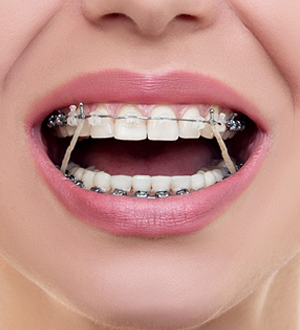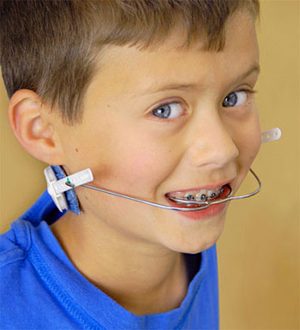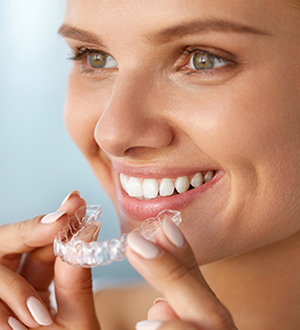You may wear bonded brackets on only your front teeth or front and back teeth. These bonded brackets could be made of metal. Tooth coloured ceramic brackets are less visible than the standard metal appliance. Ceramic brackets are recommended to those patients for whom having a visible orthodontic appliance is awkward.
Brackets could also be bonded on inside (tongue facing) surface of your teeth. These kind of braces are called lingual braces. These too help in making the treatment less visible or invisible. There are also other options in making your appliance less visible as discussed in " Other Treatment " and if the visibility is a factor that causes you concern please feel free to mention that at your very first consultation appointment, so we can devise a treatment plan keeping in mind your concerns.

On your lower teeth, you may wear a lingual arch, made of two full bands and a single wire behind your teeth.
Fitting your band is like fitting a ring on your finger except, when the right size is found, it's cemented on! For a week or two before your braces go on, you may wear separators, tiny pieces of plastic that look like tiny rubber bands or wire between your teeth to make room for your bands.
Rinsing your mouth with warm, salted water helps you feel better while you get used to braces. Your orthodontist may prescribe Crocin to relieve any minor soreness after your braces are adjusted.
May be attached to your braces to help move your teeth. Forgetting to wear your elastic is like pedaling a bike with no chain: all that work and you're not moving at all!
Be sure to wear your elastics as many hours as your orthodontist tells you to, attached as you have been shown at the office. When you go on vacation, be sure to take along an extra supply.
Be sure to take elastics to school with you in case one breaks.

You may wear headgear along with your braces to help move your teeth and jaws into correct position. Most styles of headgear have a metal face bow that slides into headgear tubes on your back teeth. Each style is used for a different bite problem.

Be sure to wear your headgear as many hours as your orthodontist tells you. When you take off your headgear, always undo the straps first, and then slide your face bow out carefully. When you're wearing your headgear, don't play rough sports: the face bow can come loose and poke your mouth or eyes. To keep your headgear clean, brush the face bow with toothpaste and wipe the straps with a damp cloth each day.
A retainer holds your teeth in their new positions while bone grows in to hold them steady. Different kinds of retainers are available and we will choose the best type of retainer for you, depending on what your original problem (malocclusion) was. You might be asked to wear a removable plate or may be given a fixed wire retainer which is stuck on the inside surface (tongue facing surface) of your teeth. Fixed wire retainers are not visible when you smile or eat and hence do not cause any social embarrassment. You may also need to use a Positioner first, to move your teeth slightly and put the finishing touch on your new smile.

Be sure to wear your retainer as many hours as your Orthodontist tells you to. Brush your retainer with toothpaste twice a day, as you brush your teeth. When you're eating, keep your retainer safely in the retainer box provided to you. Keeping a chart can help you remember to wear your retainer.
Contemporary Orthodontics:
612, 6th Floor, A wing Panchsheel Plaza,
Opposite Ghanasingh Jewelers,
N.S. Patkar Marg, Gamdevi, Mumbai 400007